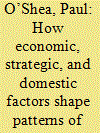| Srl | Item |
| 1 |
ID:
140410


|
|
|
|
|
| Summary/Abstract |
Despite frequent talk of conflict and even war, economic and strategic factors suggest that the Sino–Japanese dispute over the East China Sea will not erupt into hot conflict, at least for the time being. However, for domestic reasons, overt cooperation remains a distant prospect.
|
|
|
|
|
|
|
|
|
|
|
|
|
|
|
|
| 2 |
ID:
144528


|
|
|
|
|
| Summary/Abstract |
A territorial dispute over the Senkaku/Diaoyu islands has gained a high profile in Sino–Japanese relations. Since the 2012 escalation of the territorial dispute, there is no sign of any de-escalation despite economic interdependence, which previously helped ease the tension. Drawing on the constructivist understanding of threat perception and power transition theory, this article analyzes the way in which the deepening of threat perceptions associated with a perceived regional power transition prevents Japan and China from working beyond their subjective conceptions of justice associated with boarders and history. Since 2012, the Sino–Japanese territorial dispute has increasingly fitted into a larger picture of power-political conflict taking place in a power transition in which both Japan and China aim to return to ‘normality’ by propagating their territorial claims, strengthening their military capabilities, and strategic realignment. To that end, this article first introduces a theoretical framework on the centrality of threat perceptions in power transition. Second, it traces the ways in which Japan and China have developed a threat perception of each other since 1972. The third section deals with the escalation of the Sino–Japanese territorial dispute since 2010 and highlights the deepening of mutual suspicion and threat perception exemplified at the bilateral and multilateral levels. I conclude that the Sino–Japanese territorial debate entered a new stage of normative and power-political competition in earning international support for territorial claims in the East China Sea.
|
|
|
|
|
|
|
|
|
|
|
|
|
|
|
|